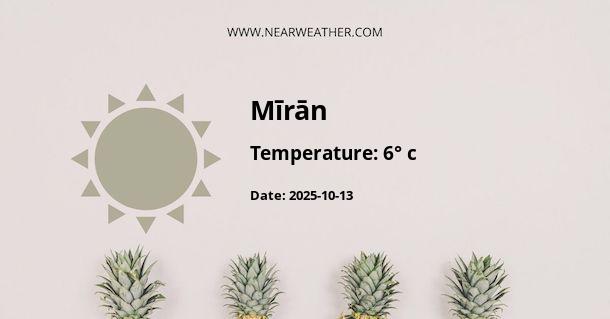Miran, Afghanistan: Climate and Weather Year Round
Miran is a small village located in the province of Helmand in southern Afghanistan. It is situated in a region that experiences a desert climate, characterized by hot and dry conditions throughout the year. The climate in Miran is influenced by its geographical location, which is close to the border with Iran and not far from the vast desert regions of the Middle East. Let's explore the climate and weather patterns in Miran throughout the year.
Temperature
The temperature in Miran can be extreme, with scorching summers and relatively mild winters. The average high temperature in the summer months, from June to September, hovers around 40-45 degrees Celsius (104-113 degrees Fahrenheit). During these months, the village experiences intense heat, with occasional heatwaves pushing the mercury above 45 degrees Celsius (113 degrees Fahrenheit).
Winter in Miran is relatively milder compared to the summer months. From November to February, the average high temperature ranges from 15-20 degrees Celsius (59-68 degrees Fahrenheit), with nighttime temperatures dropping to around 5-10 degrees Celsius (41-50 degrees Fahrenheit). Frost and occasional light snowfall can occur during the winter months, although it is not a common occurrence.
Precipitation
Miran receives very little annual rainfall, making it one of the driest regions in Afghanistan. The village experiences an arid climate with an average annual precipitation of less than 100 millimeters (4 inches). The majority of the rainfall occurs during the winter months, between December and February, with occasional showers and thunderstorms bringing some relief to the dry desert landscape.
The summer months, on the other hand, are almost completely devoid of rainfall. The lack of precipitation during this period contributes to the aridity and desert-like conditions in Miran. The limited rainfall and high evaporation rates result in a scarcity of water resources, making agriculture and water management significant challenges for the local population.
Wind and Dust Storms
Miran, being located in a desert region, experiences strong winds and occasional dust storms. The prevailing winds in the area blow from the west and southwest, picking up speed as they pass through the vast desert plains. These winds can reach gusts of 40-60 kilometers per hour (25-37 miles per hour), creating dusty conditions and reducing visibility.
Dust storms are more common during the spring months, from March to May, when the strong winds pick up loose soil particles and carry them over long distances. These dust storms can significantly impact daily life, affecting transportation, agriculture, and posing health risks due to increased levels of airborne particles.
Sunshine Hours
Miran enjoys abundant sunshine throughout the year, thanks to its location in a desert region. The village receives an average of around 3000 hours of sunshine annually, with the highest amount of sunshine occurring during the summer months. This ample sunshine contributes to the high temperatures experienced in Miran, as it intensifies the heating of the desert landscape.
Conclusion
Miran, Afghanistan, experiences a desert climate characterized by hot and dry conditions throughout the year. The temperature can be extreme, with scorching summers and relatively mild winters. The village receives minimal rainfall, primarily during the winter months, and experiences strong winds and occasional dust storms. Despite the challenging climate, Miran benefits from abundant sunshine, contributing to the high temperatures and aridity of the region.
A - Mīrān's Latitude is 34.220299 & Longitude is 68.312523.
A - Weather in Mīrān is 8° today.
A - Climate Conditions in Mīrān shows few clouds today.
A - Humidity in Mīrān is 44% today.
A - Wind speed in Mīrān is 8.39 km/h, flowing at 266° wind direction. today.
